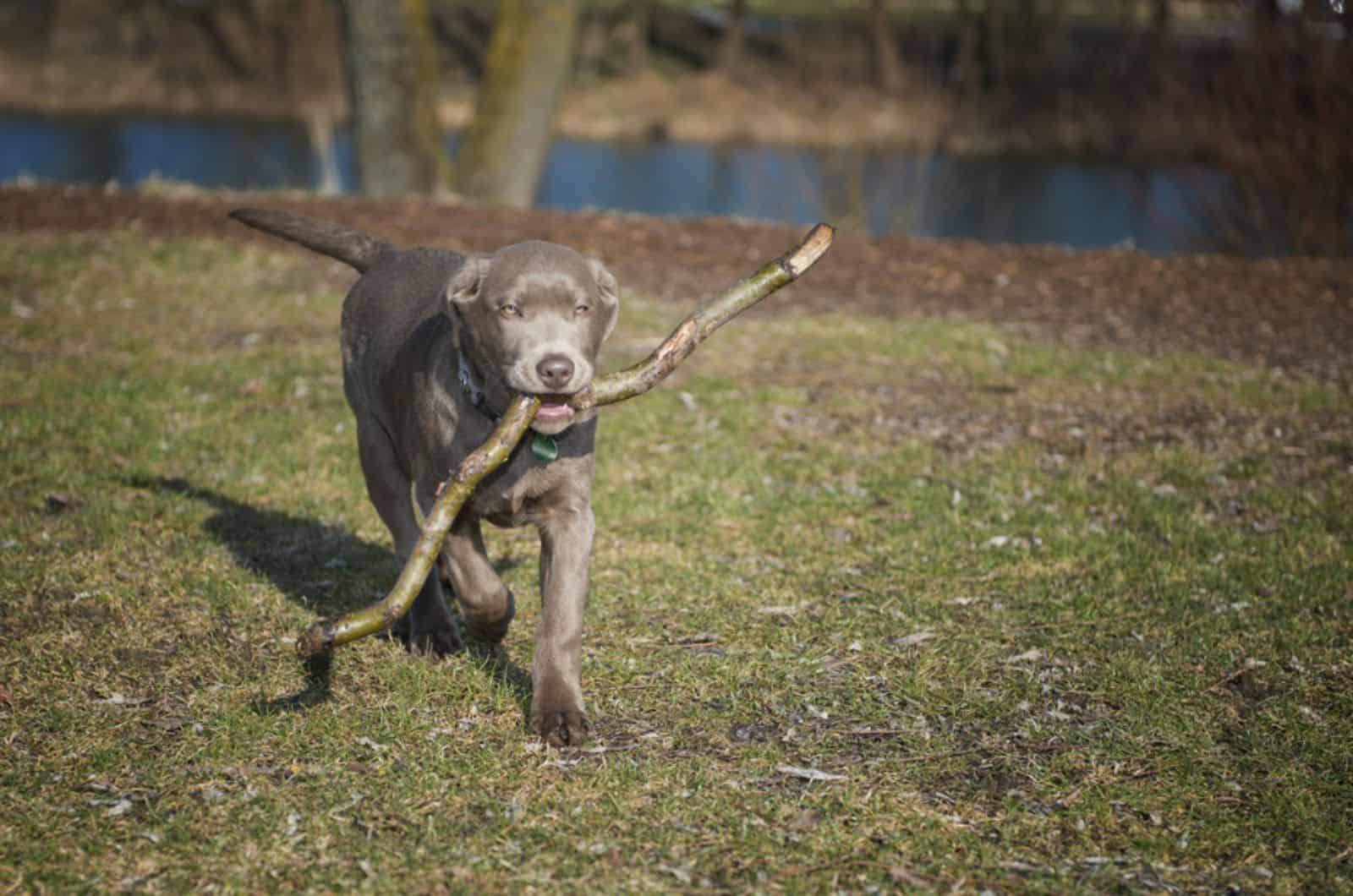The Silver Lab has always been jovial, cheerful, and welcoming – a wonderful family pet that is perfect for a busy home. If seeing the puppy litter of these beautiful dogs will make your day better, imagine what would be the case if you were to own one.
This astonishing Labrador Retriever color is something that we more often see in dog breeds such as the Great Dane and the Weimaraner. However, we are not complaining of this color being available for Labs… on the contrary, we find it remarkably beautiful!
But, what makes this one so special? Well, probably the fact that we are used to the notion of our purebred Labrador Retrievers being of chocolate, black, or golden color. And, this one stands out from the regular color schemes of Labrador Retrievers.
The Silver Lab seems to be a lovely canine that has the timeless appearance of a Labrador, but with a silvery kick! It is in the spotlight of a lot of discussion, it is stunning, and it has an outstanding personality.
Its past is unknown; however, it is thought that it could be a purebred Labrador Retriever or perhaps a Lab mix. Its popularity is increasing, along with its presence as a result of the argument.
Alas… the Silver Lab unfortunately found itself in the middle of a lot of dog-related controversy, where some people despise them and others adore them. Many breeders as well as clubs disagree about the way that the silver lab acquired its coat, and there are several competing hypotheses.
The dilute gene that changes the chocolate color of their fur to a light silvery gray gives silver Labradors an added level of uniqueness. However, that glamorous silver coat is indeed shockingly divisive!
What Is A Silver Lab?

This question cannot be answered without a few perspectives being included into the answer. As you may guess by now, the Silver Lab has been a kind of controversy in the breeders’ and dog lovers’ community.
The phrase “silver labs” was coined over the previous years by a small number of breeders who promoted and sold pets that they claimed were purebred Labrador Retrievers, including a dimmed or gray coat color.
A few of these ‘silver labs’ have been approved for registration by the AKC. The silver coats’ chocolate-colored hue appears to be the justification for this choice. It’s interesting to note that the original Weimaraner breeders were also responsible for creating ‘silver’ Labradors.
There is solid proof in the research journals that the Labrador never was recognized as having the dilute gene, dd, even though we are unable to establish that indeed, the silver Labrador seems to be a result of a Weimaraner and a Labrador being crossbred.
The uniqueness of dd is just a trait of the Weimaraner breed – the only one that is documented to have such gene mutation.
Therefore, a Silver Lab may be just a regular Lab having a genetic mutation, but some research suggests that this is actually a crossbreed with the Weimaraner.
History Of (Silver) Labrador Retrievers

The popularity of the Labrador Retriever dates back to early 19th-century Canada’s Newfoundland.
It’s a hunting dog that has spent its entire life scavenging for small aquatic animals like fish, ducks, as well as other aquatic species. It was and continues to be the fisherman’s preferred canine partner.
It had a similar appearance to his ancestor, the St. Johns Dog, which was black in hue.
It was brought back to Britain by the visiting English nobility, who also improved the breed standard and gave him the name, “Labrador Retriever”. Since then, it has established itself as a steadfast family favorite around the globe.
There is disagreement among Labrador breeders concerning the Silver Labrador. Some people think that Silver Labradors are purebred Labradors, just the same as the regular-colored ones are, while others think they are a cross between a Labrador and a Weimaraner.
In the 1950s, Kellogg’s Kennel marketed ‘unique gray Labradors’ for sale, which is when the ongoing controversy initially started.
Numerous breeders and Labrador aficionados throughout the world had issues about this since it seemed as though the silver color had appeared out of thin air. A similar argument is made in relation to other lab color variants, such as the red fox lab.
The Silver Lab is not acknowledged as an official hue despite the controversy. Worldwide kennel groups still allow them to be registered as Labradors. Nevertheless, they are still eligible for AKC registration as a “Chocolate Labrador.”
Another option is to register your dog with the AKC’s equivalent in the UK as a ‘non-recognized color.’ Uncertainty surrounds the Silver Labrador’s exact prevalence. It is obvious that the controversy surrounding them is increasing their profile.
Hypothesis Number 1: The Silver Labrador Is A Purebred

Supporters of purebred animals frequently assert that they have existed forever.
To prevent the introduction of silver genes into the Labrador’s genotype, silver Labradors have either been registered as unrecognized or quickly put to death. The breeders didn’t like being charged with mixed breeding.
It’s possible that these silver dogs got the unusual, diluted Labrador gene. If so, it might be assumed that perhaps the Silver Labrador is a genuine Labrador purebred.
Therefore, no one questioned it until Kellogg’s Kennel became the first to publicly advertise its puppies as Silver Labradors in the 1950s.
Advocates contend that the genes of the breeds that the British utilized to develop the Labrador – as we recognize it today, the St. John’s Water dog, as well as the Chesapeake Bay Retriever — hold the key to understanding.
Since that time, Silver Labradors have indeed been bred to produce even more Silver Labradors, resulting in this once-rare color now becoming increasingly common.
The silver hue, which features both bench and display lines, was first used in the UK, and then it gradually spread to the U.S.
Hypothesis Number 2: The Silver Lab Is A Crossbreed

According to those who disagree with the idea that the Silver Lab is a purebred, the only reason is that the Weimaraner’s DNA was mixed in with the gene pool. The Weimaraner resembles a Labrador in terms of size and look, with the exception that his coat is uniquely silver.
In particular, Crist Culo Kennels as well as Beaver Creek Labradors are indeed the two existing Silver Labrador breeders. Their pups might be traced all the way back to the initial one that Kellogg’s Kennels advertised in the 1950s.
Given the rarity of the silver hue, it is likely that the dogs have been bred with related individuals to produce the hue. This technique is known to cause a wide range of health issues, and it is referred to as inbreeding.
Protesters claim that by incorporating a whole other dog breed, breeders are compromising the Labrador’s gene pool.
Additionally, they claim that a number of health issues are brought on by the hybridization of Silver Labradors. Purists of the breed contend that these animals are actually mixed breeds rather than purebreds.
Additionally, they assert that those who breed Silver Labs only do so for financial gain. The usual defense is that such breeders don’t respect the Labrador breed.
Without any consideration for the dogs’ health, they merely want to breed as many Silver Labradors as they can.
Recent research, however, indicates that there are currently numerous Silver Labs in existence in order to allay fears about inbreeding. Inbreeding is not done by reputable breeders, and there has never been any evidence of misconduct.
What About The Color Genetics Behind The Silver Lab Puppy?

The Silver Labrador has, so far, been frequently described as a lighter variation of the chocolate Labrador.
The color differences are sometimes described genetically as being caused by a diluted gene that results in the ‘watered down’ color variety.
All fur colors are controlled by a collection of genes. You’ll find information about how the B and E genes affect the coat color of Black, Brown, as well as Golden standard Labradors. However, a distinct gene, the D gene, governs the silver hue. All common Labrador colors carry the D gene.
When this gene is activated, full color results; when it is off, faded color results. To better grasp it, consider that all genes exist in pairs, with the big ‘D’ and little ‘d’ making up this pair. The little d generates a diluted color, whereas the big D generates coat color at maximum capability.
Given that the Silver Lab is a light shade of chocolate, the following gene combinations and color possibilities are available again for the Chocolate Labrador: the Chocolate Lab has a DD gene combination, and may also have the Dd combination, while the Silver lab has the dd gene combination.
The big D always predominates; hence, it always takes precedence over the little d. In order for the pup to have dilute fur, the dog must therefore have duplicates of the diluted gene. Therefore, a Silver Lab could only be produced by breeding three gene combinations.
Some breeds, like Weimaraners, have two additional tiny d genes. Due to the recent development of the double tiny d mutation in Chocolate Labradors, the Silver Labrador was able to appear, which is how the controversy started.
What Does A Silver Lab Look Like?

The only difference between the Silver Labrador and other colored Labradors is, of course, their color. Others explain his hue as a sparkly silver, while several view it as a faded brown.
A Silver Labrador’s hue can vary according to its parents and genetic makeup. Their eyes are usually bright yellow, and they frequently possess a brown nose. Many puppies’ light-blue eyes, which progressively change to pale yellow after eight months of age, are common.
Some claim that the Silver Lab has a more ‘hound-like’ appearance, and that this is a result of his Weimaraner parentage, especially those who think he was mated with the breed.
Their snout is lengthier and slimmer, and their ears are bigger than those of a typical Labrador. Others claim that he doesn’t have a hound-like appearance, and just appears to be a typical Labrador.
The adult male of a Silver Lab stands between 22.5 and 24.5 inches tall. Females will be slightly shorter, measuring between 21.5 and 23.5 inches.
The male puppy is fairly large, weighing between 65 and 80 pounds. Females often range from 55 to 70 lbs.
Despite being stocky, the dogs have good proportions. Silver Labs have quite a robust snout and a sturdy neck, as well as a happy and cheeky demeanor.
Additionally, they have a long, thick tail that resembles an otter, which they utilize to propel themselves through water.
Read more about differences between a male and a female Labrador here!
What Are The Different Colors Of Labradors?
The genotypes of both parents influence the coat colors of Labradors. To generate puppies with acceptable colors, specialized breeders meticulously choose different colored Labs.
Therefore, a lot of scientific research is being done about Labrador colors. Fortunately, the Labrador Retriever now comes in some incredible color variations, thanks to selective breeding.
You’ve probably already seen the three primary Labrador colors: black, yellow, and brown. Out of these, yellow Labs are the most popular pick for dog owners.
The American Kennel Club (AKC) officially recognizes and defines these three distinct colors.
Read more about Labrador Retriever colors here!
What Color Is A Silver Lab?
Actually, these canines are not distinct compared to any other Lab. They are equally gregarious, silly, and energetic. Even their tail shares the renowned beaver tail of retrievers. However, their stunning silver coat is what makes them special.
The color of a Silver Labrador‘s coat is silvery-gray-blue. Although they are labeled as Chocolate Labs, the American Kennel Club acknowledges them as having a unique historical and genetic background to them.
These cannot be show dogs because of the debate surrounding their pedigree, but they are still capable of becoming working dogs, just as their forefathers were.
The term ‘Silver Labrador Retriever’ refers to a chocolate that has been diluted. A ‘Charcoal Labrador Retriever’ is the name for a black that has become dilute.
Personality Of A Silver Labrador Retriever: Different From The Golden?

The clever, trainable Silver Lab just exists to serve and obey his owner.
If you are persistent with its learning and correction, it will not only be one of the most obedient puppies, but it will also constantly be around you and be willing to help you anytime it can! The Silver Labrador is a fantastic choice if you’re looking for a loyal companion.
It is also a very friendly dog that enjoys playing with the family and swimming in a pool. It may catch everything you toss, keeping the whole family entertained for hours.
In addition to serving his master, it is also devoted to the other members of the family, and therefore, it will cuddle up with any person in the vicinity.
Also, if it is raised in a social environment, your Silver lab will have a soft spot for kids of all ages as well as many other animals. It is a noted sufferer of separation anxiety, so this friendliness does have a little drawback.
He is an upbeat dog that, in the words of the AKC (the American Kennel Club), is “kind, lively, and extroverted.” It has been the most popular dog breed of England and the U.S. for more than 23 years, and one of the key factors in that popularity is his personality!
Are Silver Labs Good Family Pets?
The Labrador has a large list of beneficial traits, including family dog, devoted guard dog, dependable friend, and many more. Regardless of how adorable a puppy’s personality is, it isn’t the only factor you need to take into account when choosing a dog for the family.
Additionally, you must consider the breed’s fundamental characteristics such as size, grooming needs, trainability, and health issues.
If you live in a small apartment with no back yard, then a Lab might be a terrific friend for your children. However, providing your Labrador the movement it sorely needs in this circumstance could be a challenge.
Before deciding to adopt a puppy into your house, it’s crucial to understand the fundamentals of any dog breed. The more information you have up front, the less likely it will be for you to have any huge surprises later on.
Even while labs are well-known for being excellent family pets, it’s still crucial that your new puppy and your children comprehend how to behave around one another.
Assure that your kids are aware of any specific guidelines involving your new family member, and that they understand how to behave around a dog.
Likewise, it’s crucial that you start educating your new Lab as early as you bring him home, and establish clear guidelines for what conduct is permitted and prohibited.
If you are ready to begin your hunt to expand your family with a Silver Labrador, then Silver Lab Lovers groups, as well as Labrador Retriever breeders would be a good place to start. If you choose to help a needy animal, you can also look at National Labrador Rescue Groups.
Is The Silver Labrador A Healthy Dog Breed?

The same health problems that affect other purebred Labs also affect Silver Labs, including a propensity for overeating and musculoskeletal issues!
According to two studies, a Labrador’s lifespan is somewhere around 11 to 14 years, and compared to other breeds, Labs have a higher cancer mortality rate (31% of all mortality).
Overall, though, Labs are indeed a relatively healthy and sturdy breed, immune from some of the impairments that certain other purebred dogs experience.
You should be informed that the fur color dilute gene may have some negative effects on your pet’s health.
Possible Health Issues Of A Silver Lab
Inbreeding can harm these dogs’ health in a variety of ways, just as it can harm any limited gene pool.
However, a research by LabradorNet on the population of Silver Labrador Retrievers showed that (as of 2012), the breed now has a rather good and varied gene pool.
Since there are 7 pretty diverse bloodlines, inbreeding-related health issues are less of an issue now.
Despite this, there are still worries that the prior inbreeding of these dogs has harmed their health.
When looking for a Silver Lab, it is important to exercise prudence by researching the parents’ health and ancestry. Although it is impossible to guarantee that your Labrador will never experience any of the following health issues, you can take precautions to lower your dog’s risk.
You give your pet the best opportunity of leading a long, healthy life by being proactive about his health.
1. Color Dilution Alopecia
There are times when coat issues are linked to the color diluting recessive genes – the one that gives us the light silvery coat. It also might specifically be connected to a specific type of hair loss.
The condition, referred to as “color dilution alopecia“, is more prevalent in dogs with the color dilution mutation, including Weimaraners and, as of late, silver Labradors.
Although it rarely poses a threat to life, the illness cannot be cured. It may cause recurring infections in the follicles and gradual loss of hair in young dogs.
Skin issues are not always caused by coat dilution. The majority of silvers are completely free of alopecia, and therefore, not all canines with the said dd genes contain the defective alopecia version.
Therefore, the healthiness of a Silver Lab is generally comparable with that of any other colored purebred Labrador.
2. Joint Problems
Sometimes, Labs experience joint issues, such as dysplasia, in their hip or elbow.
These illnesses damage the elbow or hip joint, making it difficult to move normally, and resulting in discomfort and immobility.
The symptoms of dysplasia are decreased when your dog keeps a healthy body weight, consumes a high-quality diet with lots of vital nutrients, and participates in appropriate low-impact exercise, even though the condition cannot be completely prevented (swimming is ideal).
Additionally, there are numerous supplements designed expressly for canine joint issues, but since their effectiveness hasn’t been properly investigated, it’s advisable to speak with a doctor before using any of these.
A genetic musculoskeletal disorder called hip dysplasia causes the femur head to not fit tightly into the hip joint. Due to the femoral head’s propensity to rub against the hip socket, the hip joint eventually undergoes bone remodeling, which causes arthritis.
Progressive joint disease in the elbow is the result of multiple genetic orthopedic problems, together referred to as elbow dysplasia.
Any of these ailments may result in forelimb lameness, especially after exercise. When a veterinarian examines the elbow’s range of motion, pain is frequently found.
Elbow dysplasia can occasionally affect both elbows. The most frequent tests used to identify this illness are X-rays, and sophisticated imaging (CT scans).
The only option for treating elbow dysplasia is orthopedic surgery. If surgery is performed only when the dog is small and the illness cycle is in its initial stages, there is typically a fair prognosis. It is not advisable to breed Labrador Retrievers with a background of elbow dysplasia.
3. Centronuclear Myopathy
Skeletal muscle is affected by the uncommon congenital condition known as centronuclear myopathy (CNM). The hind limbs’ reflexes deteriorate in this situation.
Clinical symptoms include an irregular stride and the inability to engage in physical activity, such as running or walking. Particularly, in colder regions, the muscles deteriorate.
In Labradors, symptoms typically appear between the ages of 2 and 5 months. By the time a dog reaches age 1, its face, neck, and leg muscles have typically started to atrophy, leading to weakness and persistent gait problems. After one year of age, the situation typically stabilizes.
For the diagnosis of this illness, a muscular biopsy is required. The preferred form of treatment is genetic therapy. The gene disorder for CNM in Labrador Retrievers can be detected by DNA testing.
4. Nutritional Dilated Cardiomyopathy
It is possible for Labrador Retrievers to develop nutritional dilated cardiomyopathy by consuming a grain-free diet that consists of peas, beans, or lentils, among some of the five top nutrients. The heart becomes dilated and dysfunctional as a result of DCM.
Asymptomatic Labrador Retrievers having mild to severe DCM are possible. Some signs are rapid heartbeat, coughing, respiratory problems, drowsiness, loss of appetite, fainting, losing weight, and sometimes even death.
An NT-proBNP analysis – a diagnostic test that assesses heart function, could be used to identify this heart problem in the beginning if a veterinarian hears a heart murmur during a regular exam.
In order to determine the cause, further tests (hypertension, lung X-rays, as well as echocardiogram) would be advised if a Labrador Retriever exhibits increased proBNP and/or a cardiac murmur.
Early detection of nutritional DCM allows for its reversal through giving the dog a greater meal rich in grains as well as cardiac vitamins.
If it is advanced, heart drugs may be able to treat the disease for a while, but the disease cannot be reversed at that point. By providing your Labrador with well-balanced food that contains grains, you can stop this problem from occurring.
5. Exercise-Induced Collapse
The hind limbs are first affected by the hereditary neuromuscular illness known as exercise-induced collapse (EIC).
After intense exercise or excitement, a Labrador Retriever having EIC may experience bouts of reduced muscle tone in the rear limbs. There will be an abrupt weakness in the hind limbs, which might cause stumbling or perhaps collapsing when walking.
Dogs normally bounce back, although subsequent episodes of EIC are possible. A dog’s rectal temperature during an episode can reach 107°F, which is dangerous.
Around their first birthday, Labrador Retrievers having EIC typically begin experiencing episodes. If your dog has EIC, your vet may help you choose the best course of action.
The genetic mutation that puts Labrador Retrievers at risk for EIC can be identified with a DNA test. It is not advisable to breed dogs that carry the genetic mutation.
How To Properly Take Care Of A Silver Labrador

When taking into consideration all of the basic necessities of your silver Lab, there aren’t actually many.
These dogs are easy to take care of, and you won’t need as many things to keep these dogs in check.
Grooming
Although they don’t need much grooming, Labrador Retrievers shed a lot. You should include brushing and deshedding in your everyday tasks, along with monthly hygiene maintenance regimens.
Although Labrador Retrievers don’t need any special skincare products, it’s crucial to make sure that they are completely dry after swims and baths in order to prevent skin problems.
The thick, double coat of Labrador Retrievers repels water. When a dog has a double coat, it signifies that a layer of longer hair covers a dense undercoat of short hair.
The double coat of the Labrador Retriever causes it to shed a lot, and frequent brushing is necessary to keep the shedding under control.
In order to maintain a clean coat and skin, Labrador Retrievers occasionally need to have a bath.
It’s typical for Labrador Retrievers to occasionally have a tiny portion of clear or brown ocular discharge. It’s beneficial to wipe up eye discharge with a damp washcloth as soon as it occurs.
Ear infections are common in Labrador Retrievers because of their drooping ears and love of swimming.
To reduce the chance of ear infections, it’s beneficial to regularly clean their ears with the use of an ear cleanser that includes a drying agent every two to three weeks, or after bathing and swimming.
Dietary Requirements
When they’re a year old, Labrador Retriever puppies must be fed a premium puppy formula designed for large breeds. When they become adults, they must switch to a superior adult formula designed for large breeds.
You should discuss acceptable dog meals that are not grain-free with your veterinarian in order to prevent issues from dietary dilated cardiomyopathy (DCM). This heart issue has been connected to a diet that is free of grains and high in peas, beans, or lentils.
Verify that the dog food you select has been endorsed only by the Association of American Feed Control Authorities (AAFCA).
Morning and evening feedings twice a day are ideal for Labrador Retrievers. They enjoy eating, and are noted for eating swiftly. If you see your dog chowing down on food, think about a slow-feeding gadget.
As a result, your dog won’t be able to consume as much food at once, and won’t experience stomach distress and regurgitation that can occur when they eat too fast.
Due to their deep chest, Labrador Retrievers are susceptible to bloat – an emergency condition in which the belly twists on itself.
When they are younger than 12 months old, feed Labrador Retriever puppies a high-quality pup formula because they go through quick growth spurts.
The extra calories that puppies require to reach their maximum growth potential will be provided by puppy food. Based on age and anticipated body weight, feed your large-breed puppy according to the instructions on the side of the bag.
Check the feeding recommendations on the package, and consult with your vet about the Labrador Retriever feeding chart in order to find the right amounts to help keep a balanced weight for your Labrador Retriever.
Exercise And Training

Puppies of Labrador Retrievers have a lot of energy, and they will develop into very powerful canines. When they are young, it is crucial to give them proper training.
Puppies of Labrador Retrievers should take puppy and obedience training programs, which is highly advised. They must be socialized with a variety of people and animals so that they become accustomed to being around people and animals early on.
If your puppy starts to bite, snarl, chew on things, or tries to devour things out of nowhere, make sure to correct them right away so that they don’t persist and get worse over time.
The Silver Labrador will be an energetic dog because it is bred as a working dog. A daily workout of about 60 minutes is required for Silver Labs.
This does not imply, however, that a daily walk for an hour will be sufficient. Like all Labradors, they need to move vigorously to burn excess energy.
Silver Labradors will require interactive, quick-paced activities. It is advised to train your lab to run or walk while wearing a harness because they make great running buddies.
They also like playing interactive games, participating in agility challenges, and fetch. They still love the water because they were the original fisherman’s companion; thus, swimming is another activity they can do!
One of the smartest dogs in the world is the Silver Labrador. One of the key reasons for the widespread employment of Labradors in labor-intensive occupations is because they work well as search and rescue dogs, service dogs, drug-detection dogs, and blind-guiding dogs.
They will always try to amaze you with their abilities if you mix their cleverness alongside their desire to please their master. Ensure that you have a lot of toys on hand to keep your dog occupied.
Final Word
This wonderful retriever breed is a great option for first-time owners, and they will easily become your best friend.
Many people claim that there is color prejudice against their Silver Labradors in competitions. If you place a high value on entering your Silver Lab into events, you should be ready for this. Consider a Labrador in a different hue if this is a deciding factor.
After responding to the competition issue, there are a few further points to consider. First, many opponents of Silver Labs argue that major health problems have resulted from inbreeding.
Taking good care of a Silver Lab is as equally important as taking good care of a Black Lab, a Charcoal Lab, a Golden Retriever, or a Labradoodle. It experiences the same health problems as a typical Labrador.
There may also be an additional problem with alopecia. Reputable lab breeders no longer breed siblings or other close relatives since the Silver Lab’s genetic pool has grown sufficiently enough.
Second, many anti-silver activists assert that those who breed Silver Labradors only do so for financial gain. Once more, this is untrue.
No matter which side of the argument you are on, or whether you think the Silver Labrador is a purebred or perhaps a mixed breed, there are two facts that are undeniably true. First off, it’s likely that no one will ever fully understand how their coat color came to be.
Second, and perhaps more crucially, Silver Labradors are wonderful family dogs regardless of their genetic makeup. It will enjoy a long, wonderful life with you as long as it is fit and active, and that you are prepared to have a dog.
Read Next: 12 Best Labrador Breeders In Michigan
